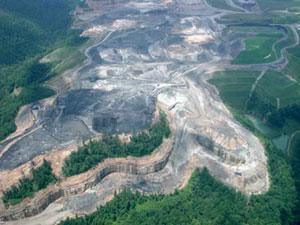At first it sounds great: Deutsche Bank, Goldman Sachs and JP Morgan Chase have signed onto NYC’s Carbon Challenge, committing them to cut greenhouse
gas emissions 40% over the next 10 years.
But where are those cuts coming from? From their offices, and while that’s important, they have a small footprint compared to the banks’ investments.
Despite the decline in US coal consumption we’ve seen – down 11% in the past two years), banks continued to pump $20.8 billion into the coal industry during 2012.
In the fourth annual report on who’s financing coal – the largest source of carbon emissions – JPMorgan Chase, Bank of America
and Citigroup ranked as the top financiers of the "worst of the worst" coal companies, including operators of coal-fired power plants and mountaintop removal coal mines.

In "Extreme Investments: Coal Finance Report Card 2013," the top 10 US banks all received C, D and F grades.
Below, the first grade is for supporting mountaintop removal and the second is for financing coal plants to extend their lives or expand.
Bank of America: C-, D
Citigroup: C-, D
JP Morgan Chase: D+, D
Goldman Sachs: D, D
BNY Mellon: F, F
HSBC North America: D+, C-
Morgan Stanley: C-, D
PNC Financial: C-, F
US Bank: D, D
Wells Fargo: C, D
While many of these banks have adopted environmental policies and due diligence processes, they haven’t had measurable impact on financing the most polluting coal companies.
For example, Wells Fargo announced it would finance $30 billion in renewable energy projects through 2020 after spending $2.7 billion since 2006. It also has the strongest policy against financing mountaintop removal coal mining.
A growing body of environmental and public health literature documents the staggering environmental and human costs of coal. According to Harvard School of Public Health study, for example, coal mining and power generation in the US costs as much as $500 billion a year in the form of cardiovascular diseases caused by coal plant emissions to cancer and chronic disease in communities impacted by mountaintop removal coal mines.
"Operations like those at Arch Coal and Alpha Natural Resources are awful investments for the American
banking industry. In fact, shares of companies with mountain removal mines lost an average of 40% of their value between April 2012 and April 2013 and only one of the 13 largest companies had an S&P credit rating above ‘junk,’" says Mark Kresowik, policy analyst for the Sierra Club.
The report concludes the environmental, social and financial risks involved with the lifecycle of coal from mining, to production to export are likely to grow more acute over time. It urges banks to shift financing toward clean energy and plan for a carbon constrained future.
Recommendations include:
- phase out lending to the
largest mountaintop removal coal firms - ensure coal financing deals commit banks and companies to emissions reductions
- withhold financing for new coal export terminals
Another report, "Bankrolling Climate Change," examined banks worldwide and found that coal financing almost doubled from 2005-2010. The 93 banks analyzed in the study have financed coal to the tune of $309 billion.
Coal plants are expensive, typically costing about $2 billion to build a 600 megawatt plant. They can’t be built without financing.
Almost all the banks in the top 20 have made far-reaching commitments to addressing climate change.
Here’s the report:
